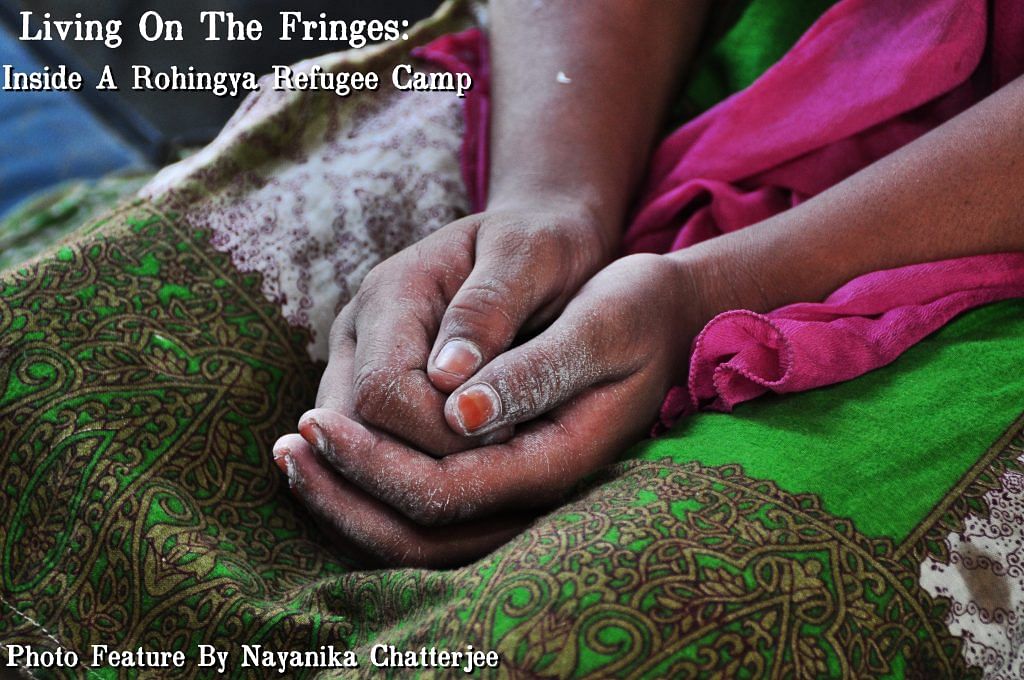Rohingyas, an ethnic minority from Myanmar, have been facing persecution at the hands of Buddhist nationalists and the army in their homeland. A recent surge of violence has seen an exodus to Bangladesh, but India also has a sizeable population of Rohingya refugees. The Indian government’s recent decision to deport them back to Myanmar has instilled fear among those staying in camps across the country.
ThePrint visited one Rohingya refugee camp, situated in Shaheen Bagh, New Delhi.
A Wired Divide
An unpaved road strewn with plastic leads to the entrance of the camp near Jasola Apollo metro station. The barbed wire separates the city folks from the inhabitants of the refugee camp—When we asked them for directions, they seemed unaware of such an establishment existing.
Lives packed away
Further inside the camp, several large blue and green plastic bags can be spotted, piled on top of one another. These are full of waste, waiting to be segregated by the ragpickers who have settled inside.
The Point of Distinction
Across from the pile of bags, there are wicker baskets brimming with dried fish, a popular delicacy amongst the Rohingyas There is a clear divide between the two nationalities. Indian ragpickers on the left and Rohingyas on the right.
Rashida
Rashida moved to the country 20 years ago after she decided to escape the violence that was being inflicted upon Rohingyas back in Myanmar. When asked about the government’s recent decision to deport illegal migrants, she said, “If ten of my people move from here, I will not hesitate to join them. I will go wherever my people decide to go.”
Born away from home
Basic necessities?
Her daughter showed us the donations they received from NGOs that look after the welfare of Rohingya refugees — shampoo and oil.
Treats amid hardship
In the neighbourhood, some Rohingyas have set up small shops which sell various kinds of snacks. The plastic packets for many of the snacks ironically, even have the “Make in India” logo.
Barely any relief
This is a toilet at the camp. Although the refugees have been asking for better sanitation facilities, nothing has been constructed for them. There are about three makeshift toilets without any septic tank.
Inside the toilet
A broken pan inside one of the toilets.
River of filth
An open drain carrying sewage poses health risks to the inhabitants of the camp.
Dil Mohammad
Dil Mohammad moved to the camp four years ago after shifting from Saharanpur in Uttar Pradesh. He does not like to think about what would happen if he and his family are ever sent back. “We’ll move to another camp in Myanmar and even that will be burned down,” he says. “Bangladeshis came to India and stayed here when India and Pakistan were fighting. When things got better, they moved back to their land. We will do the same once the situation improves. We are all law-abiding people; we are not a threat for Indians, as has been projected.”
Shirajullah
Mohammad Shirajullah migrated to India in September 2012 during a particularly bad surge of violence against Rohingyas in Myanmar. He has several stab wounds on his back from being attacked. He fled to India across the Bay of Bengal, rowing through the rough waters, and sometimes walking long distances just to make it across the Bangladesh border. When he got to Kolkata he took a train to Delhi and from there, a train to Jammu, which also has a population of Rohingyas. Eventually he moved back to Delhi, and got a job as an interpreter with the United Nations. With the money he earned from this job, he enrolled himself in a computer course. He explained that all 70 families living in the camp have been registered. “Kill us here if you want but don’t send us back there,” he says.
Earning a living
This 12-year-old girl only recently migrated to the country. She says her mother decided to flee Myanmar after they saw their family members getting beaten up in front of them. She has become a rag picker to help make ends meet. Her hands have become rough and dry because of the strenuous job.
